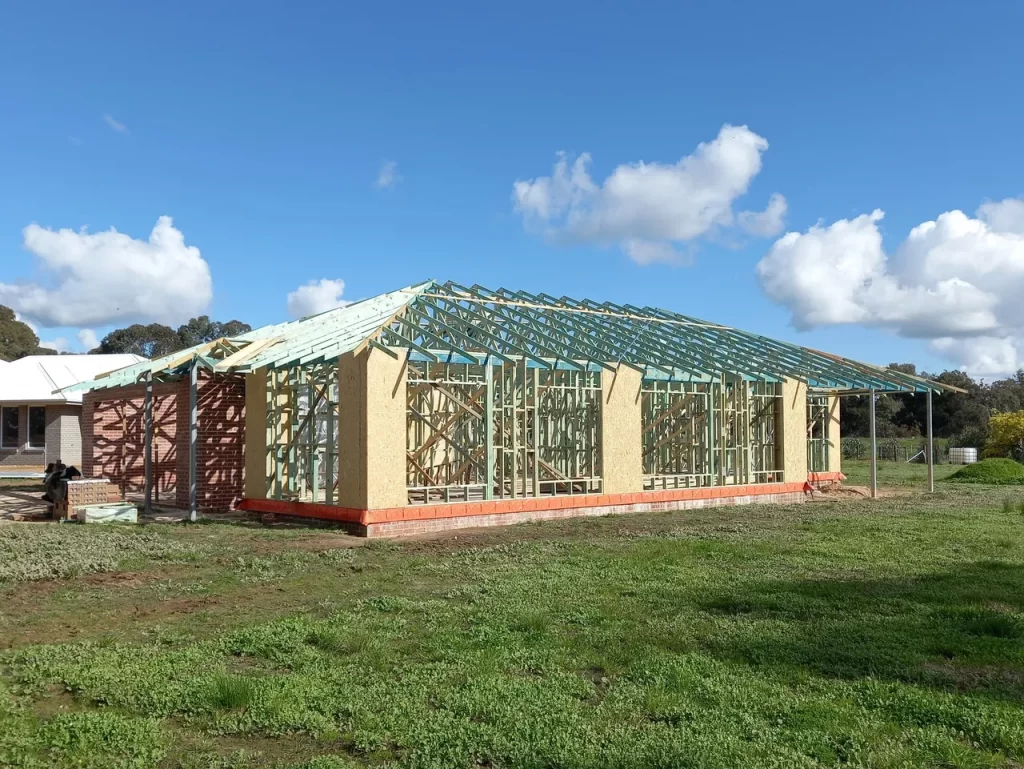By Lorraine and Daniel Offermann
We decided to build a low-maintenance, energy efficient home using standard construction techniques on a modest budget. We are currently in the construction phase and hope to be completed early next year.
A couple of years ago, we set a goal to move out of our 1970’s west end house in Wangaratta, and buy or construct a property on a larger block. It became apparent to us that the properties available on the market didn’t suit our needs, so in order to get what we wanted, we would need to build a new home. We found a lovely 1-acre plot in Oxley, complete with a 400-year old river red gum on the northern side which could provide a focus for our views.
Orientation of the house was one of the most important considerations for us when deciding on a floor plan. We wanted the living areas to face north in order to soak up the warm winter sun, but with appropriate shading so that when the summer sun is high in the sky, the windows were shaded. This passive heating should help to reduce our heating costs in winter and cooling costs in summer. Additionally, we wanted to eliminate, or at least minimise, west facing windows to avoid the hot summer afternoon sun which roasts the property and leads to greater reliance on air conditioning overnight. Southern windows were also to be minimised to prevent heat escaping from the house in the cooler months.
We investigated the layouts provided by a number of volume builders, but to our dismay, it seemed that little or no consideration was given to orientation. We set about designing our own floor plan and used a freely available web-based design software to visualise our ideas. There were many other resources available online, the most comprehensive was www.yourhome.gov.au. After many iterations, we finally came up with an appropriately sized house design that we were happy with. We got our plans drawn up by a local draughts-person and then engaged a quality local builder who was recommended to us.
The plans were sent to an energy assessor to be rated according to the Nationwide House Energy Rating Scheme (NatHERS) where a rating up to a maximum of 10-star is calculated. New builds are currently required to meet a minimum 6-star energy rating. For Wangaratta and Oxley (Zone 66), a 6-star home is expected to use 197 MJ/m 2 per year to maintain a comfortable temperature. We were very pleased that our house was rated an impressive 8-star, taking just 90 MJ/m 2 per year to heat and cool. This is less than half of the energy required for a 6-star house and will obviously have an impact not only on our bills and comfort levels, but on the environment as well.
To achieve this level of energy efficiency, we also selected double glazed windows with low-E glass. This means that less heat passes through the window, keeping more heat in during winter and out during summer. The Window Energy Rating Scheme (WERS) website is a useful resource to select appropriate windows for the structure. The windows were also positioned to allow cross ventilation to capture cooling breezes in summer. In combination with several ceiling fans, this minimises the use of air conditioning.
All the walls of the house are well insulated with R-2.5 batts and the ceiling has R-6.0 batts as well as a R-1.3 roof blanket. Insulation was also added beneath the concrete slab (R-2.4). We avoided dark colours for the roof to prevent excessive warming of the roof space in summer.
The home is all-electric and climate controlled with a ducted reverse cycle system. Solar panels will be installed on the north to keep costs down and the solar hot water system is electric boosted. The north-facing living areas have tiled flooring directly on the concrete slab to provide thermal mass. This absorbs the warm winter sun and releases the heat slowly into the house, again minimising reliance on electric heating.
We will also consider planting a deciduous vine on a north-facing pergola and/or along the western wall should additional shading be required in summer.
We look forward to the completion of our build and living in a property which is able to maintain a comfortable temperature throughout the year. We found that designing our own affordable, energy efficient home is both achievable and worthwhile.

